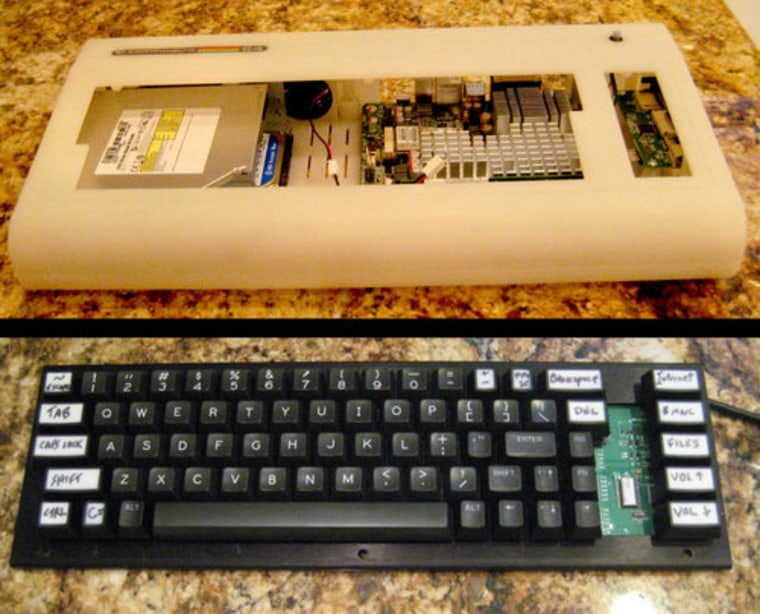The hard part isn't building the computer: Sticking modern components inside a shell shaped like an old Commodore 64 is no great challenge. Neither was matching the price of the original: It cost $595 then, and the "basic" config costs $595 now. No, the hard part is getting the color right. Enthusiasts would know if it was off. But there was a problem: Pantone doesn't have a match for "Commodore 64 tan."
"The color for the original Commodore must been invented by an alien," Barry Altman, CEO of Commodore USA — which licensed the brand in order to build a modernized reincarnation of the classic computer — told me. This color issue turned into his biggest headache.
"The only way to create exact original color was to take the original piece and have it spectrograph analyzed, in infrared and visual light spectrum and beyond," he said. "The cost was atrocious, and the cost of the chemical dye is even sicker."
Altman's initiative is something of a curiosity: In the early 1980s, the Commodore 64 was known for its simple accessible design and solid programming platform, but to relaunch it in the era of the iPad seems, well, a bit quixotic. Altman assures me that this is no hare-brained man-on-a-mission endeavor, though. He likes the classic computer's in-the-keyboard form-factor, which he thinks has been overlooked in modern PC design, but this Commodore venture is a response to what he says is popular demand.

"Simplicity, low cost, superior graphics, quality sound, good game software and aggressive marketing made the C64 a blockbuster success," according to the Computer History Museum, which has a gallery of C64 shots and an original ad which touted its low price. "Over more than a decade, about 30 million were sold, many in retail stores that had never sold computers before." Still, there hasn't been a new Commodore 64 for sale since 1994.
It's hard to gauge the pent-up demand for a long-extinct computer, regardless of its former popularity, but Altman says people were begging him to relaunch the C64, and now many of those people are paying Altman to turn their nostalgic dream into hard plastic reality. Pre-sales started last week, and are "beyond crazy," says Altman.
For buyers, this is still very much a leap of faith. Altman admits that he doesn't yet have a photo of the production C64 that he's selling. (As you see here, shots on the site are either computer renderings or snapshots of the prototype, sans tan.) He is hoping to start shipping it by the end of April or early May.

The hold-up isn't due to the internal organs. All of the components in the box are off-the-shelf, says Altman. Seriously, it's just a PC, with an Intel Atom processor and Nvidia graphics — even an HDMI port — plus optional Wi-Fi and Blu-ray drive.
"The problem is the case. We can't just go buy a case, we have to make it."
Because of this, the company had to commission a precise mold, at a substantial cost. With just one mold, the company is limited to a production run of 25,000 per month. Altman says that now that the orders are coming in, he's commissioning a second mold, and may add still more later.

The company is also promising a brand new Commodore OS. Altman says it is an elegant Linux-based system that manages to take design cues from the original, but is as much a leap as Apple's Mac OS X was from the UNIX foundation upon which that was built. But the new Commodore OS may not be ready in time to ship with the hardware. (Altman doesn't yet have screenshots.) In that case, he will drop in a version of the readily available Ubuntu Linux system. Users will have the option of installing their own version of Windows. When the fresh Commodore OS finally arrives, it will be mailed to users "free of charge."
So the question becomes, who, exactly, would want a new but fairly basic computer tucked inside the case of one of the all-time classic computers? Are there enough C64 nerds out there to keep Altman's business thriving? He says the owner of the Commodore name, Commodore Licensing BV in the Netherlands, has additional plans to license the logo to all manner of devices, from tablets to phones.
Chris Garcia, curator of the Computer History Museum, says that nostalgia for old "8-bit" systems has been quite powerful in the past decade, particularly in art, music and gaming. His favorite is a band called 8-bit Weapon, which has even used C64s to create their retro sound.
"There are maybe hundreds of thousands who love the retro feel, and still use it frequently," says Garcia. Still, this isn't exactly a retro play. It's more of an update, that Garcia likens to the rebirth of the Volkswagen Beetle, or the Mini. "Even if it were just shaped like a C64, it will probably attract a following."
It's one thing to see a fun novelty machine selling to a nostalgic enthusiast crowd, it's another thing altogether to envision an industry comeback for a brand that hasn't existed for nearly two decades. Still, if even a fraction of the tens of millions of former C64 owners do step forward — with cash in hand — Altman will get a nice bit of business.
More recent computer news from msnbc.com's Technolog:
- New Photoshop apps let iPads run the show
- Microsoft readies 17 software patches for 64 holes
- Acer's first Honeycomb tablet: Available on April 24 for $450
You can catch up with Wilson on Twitter at @wjrothman, or skip the one-on-one and join our conversation at Technolog's Facebook page.
